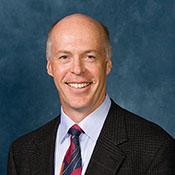Lecturer IV DAVID CHESNEY (Computer Science and Engineering, College of Engineering) won the Provost's Teaching Innovation Prize in 2016 for his project, Developing Software Systems for Children with Disabilities.

Creating opportunities for students to engage deeply with “real-world” problems has long been recognized as a high-impact teaching practice. In EECS 481, the innovation lies in the web of relationships that connect undergraduates in the capstone software engineering course with a child (identified by CS Mott Children’s Hospital) who could benefit from assistive technologies.
Students learn about a specific disability selected for the semester from clinical faculty and through interaction with the child and family. After an overview of cutting-edge technologies, each student writes a one-page proposal for developing software that aims to improve quality of life for a cognitively or physically impaired audience. After experts select the best proposals, the student creators “pitch” to the rest of the class to recruit 3-4 teammates. Teams develop, document, and celebrate three product releases in a “tradeshow floor” format over the course of the semester. In addition to hard technical skills, students also figure out soft skills, especially how to work effectively as a team and manage their time.
Not only have course enrollments grown substantially since 2009 (table below), but women are participating at twice the national average for computer science courses (25-30% vs. 10-15%).
Student Comments
“It was a ‘greater-good’ type of class, developing products for people with unique needs.”
“Software engineering can feel far removed from actual people ... EECS 481 tries to put people at the center of every design decision.”
“We interacted with children and their families so we could better suit our projects to the needs of our users.”
“Few things learned in school have helped my transition into the working world better than what EECS 481 taught me about project planning.”
“As a maker, it improved my ability to incorporate empathy into my work.”
“The innovative design of this course gives students space to work and stretch their creativity.”
“I learned many different ways to make sure I design for the user.”
“It was the only capstone course offering the opportunity to develop technology for the purpose of positively impacting the lives of real people.”





